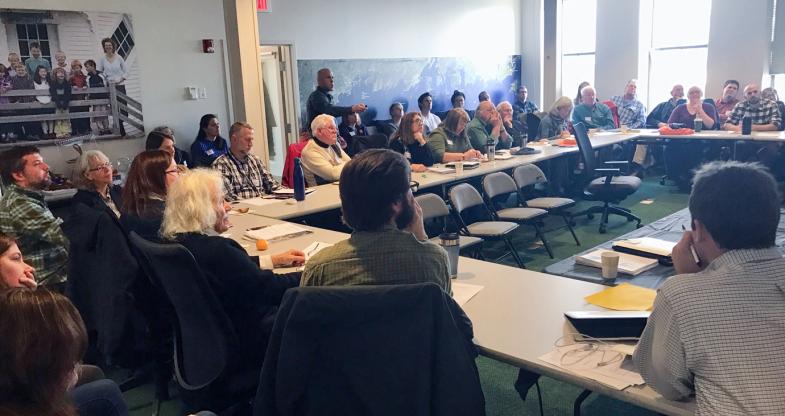
Tyler Kidder / GrowSmart Maine
In recent years, Maine and coastal communities around the world have been feeling the impacts of climate change. With rising sea levels, higher tides, and increasing storm surges causing flooding, property damage, and serious environmental issues along Maine’s 3,500-mile coastline, local communities are looking for solutions to address this growing trend.
To help island and coastal communities address these issues, the Island Institute and GrowSmart Maine hosted a forum on December 9, 2016, focusing on sea level rise and its potential impact on coastal Maine. We brought together expert panelists and community members to discuss what coastal, estuarine, and tidal river communities can do to deal with sea level rise and storm surge in Maine, and provide practical tools for local implementation.
Sea Level Rise and Causes
According to Peter Slovinsky, marine geologist with the Maine Department of Agriculture, Conservation, and Forestry, global sea level rise has seen a sharp increase since 1993, averaging 3.4 mm/year over the previous century average of 1.8 mm/year. In close comparison, Portland’s sea levels have risen from 1.9 mm/year to 3.3 mm/year during the same period, with recent spikes in 2009 and 2010 and further evidence pointing to higher rises in both the short and long term. Primary factors for the higher seas include melting of land-based ice sheets and glaciers and thermal expansion, or the heating of the oceans.
Making a Plan
With rising seas and expanding flood zones, experts are urging communities to make plans now, identify the risk in their areas, and develop a comprehensive plan for addressing them. To this point, Jon Edgerton of Wright-Pierce, an environmental engineering firm, walked attendees through the steps for developing a plan like this – from identifying elements at risk, including buildings, roads, wharfs and waste treatment facilities – to estimating the consequences, possible scenarios to address them, costs and implementation. While this may seem like a daunting task for many island and coastal towns, Edgerton noted the importance of using the plan and keeping the big picture in mind, stressing that once the research has been done, it can be implemented in pieces to help conserve costs as much as possible.
The Role of Conservation
In addition to this type of comprehensive planning, communities can help support coastal conservation efforts like those of Maine Coast Heritage Trust (MCHT), which is working to preserve tidal marshes affected by sea level rise through land conservation to support new marsh habitats. As Jeremy Gabrielson of MCHT noted, tidal marshes are a natural mitigator of storm surges, as they reduce the effect of wave action and can protect inland infrastructure. They’re also a rare ecosystem in Maine. By preserving these habitats, we can maintain a natural resource that protects against rising seas, keeps our coastal waters clean, and supports our coastal economy.
What Can Communities Do?
Community involvement is also a key factor in addressing these concerns. Local representatives in attendance stressed the importance of municipalities and town government taking the lead. Vinalhaven Selectman Phil Crossman talked about the work his island is doing to assess the vulnerability of its downtown and working waterfront to sea level rise. By working with regional planning organizations, supporting local efforts, and bringing people together to encourage conversations and consensus building, presenters agreed that we can all play a role in addressing important issues like these to ensure the sustainability of Maine’s coastal areas.
For more information, including a video link of the session, downloadable presentations from the speakers, and additional resources, visit the GrowSmart Maine Sea Level Rise Forum event page.
About GrowSmart Maine
The mission of GrowSmart Maine is to build lasting prosperity without sacrificing the quality of life that defines Maine. A statewide organization, it promotes sustainable prosperity for all Mainers by focusing on the connections between conservation of natural resources, community revitalization and economic development. Its work includes convening and engaging in public conversations about Maine’s future, contributing common sense policy analysis, educating the public, advocating for state and local change, and supporting model practices. For more information on GrowSmart Maine, visit http://growsmartmaine.org.
Additional Resources:
Conference: It’s time to plan for higher seas; The Working Waterfront, January 9, 2017

Contributed by